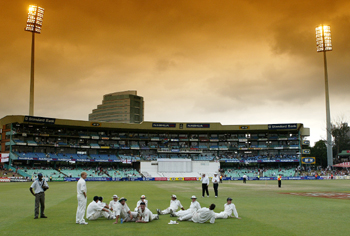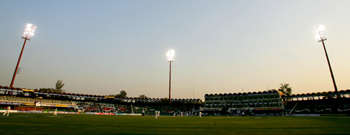Photographs: Reuters
Only one final obstacle now prevents the International Cricket Council introducing floodlit day-night Test matches as it confronts dwindling support for the five-day game.
Experiments over the past two years have shown that either pink or orange balls in place of the traditional red can be seen clearly under lights.
Now the problem is not visibility but whether the ball can retain its colour for the minimum 80 overs required before the fielding side can ask for a new ball.
Consequently over the next year a pink ball with a black seam, which was used in the Marylebone Cricket Club's (MCC) annual season-opening fixture against county champions Nottinghamshire in Abu Dhabi this year, will be trialled throughout the world.
"This time next year I hope we will be in a position, hopefully, to recommend it be used in a day-night Test match," ICC general manager Dave Richardson told reporters at Lord's last week.
"The principal aim now is just to confirm that the ball in most conditions can sustain itself for long enough."
Although Richardson is sanguine about the future of five-day Tests, the reality is that attendances in the 10 Test nations, apart from England, Australia and Bangladesh, have plummeted.
Elsewhere, one-day cricket in either its 50- or 20-over versions is proving consistently more popular with fans whose time and money need to be husbanded carefully in times of continuing economic uncertainty.
Mindful of the need to preserve the pre-eminence of Test matches, still the form of the game regarded by players and cricket enthusiasts alike as the most satisfying and meaningful, the ICC has concluded that day-night cricket is one way ahead.
"I'm not as pessimistic as some people as far as the necessity to save Test cricket is concerned," Richardson said.
"I think Test cricket is pretty healthy in a number of countries. But I do think it affords the boards the opportunity to play Test cricket at times where more people are available to go and watch in the evening sessions.
"I also know commercially it can be valuable to play at those times of the day. The hours of six to nine in the evening are prime viewing time and they can charge more for the advertisements during that time.
"Commercially I know it makes sense to be able to play Test cricket at that time.
"The main reason for me would be to go to work on Thursday and Friday and also maybe go to watch the Test match in the evening."
Day-night cricket was introduced in Kerry Packer's 1977-78 rebel World Series where coloured clothing, a white ball and a black sightscreen, still staples of one-day cricket, were employed for the first time.
Experiments have been conducted with different coloured balls
Image: A floodlit Gaddafi stadiumTest cricket, though, is played in traditional whites with a red ball and to this end experiments have been conducted with different coloured balls which can be seen clearly under lights.
The MCC experiment was regarded as a success but the ICC's cricket committee, headed by Clive Lloyd who captained West Indies in World Series Cricket, concluded further Tests were needed in potentially more difficult conditions.
"Conditions were fairly benign, the outfield was a good one, there was no dew so we thought what we need is a period of further trialling," Richardson explained.
He said the pink ball would be employed in the ICC's Intercontinental Cup, a four-day competition between associate member countries such as Ireland and the Netherlands, while the 10 full member nations would be encouraged to use it in at least one round of their domestic competitions.
A floodlit Test will happen before 2014
Image: Lights come up at Lord'sRichardson, a former South Africa wicketkeeper, said the committee was concerned about the endurance of the ball "in conditions where there is maybe early morning dew, where you have a rain spell, occasions when the outfields are damp".
"We haven't gone into which countries would have climates that are suitable but I would imagine that most of the 10 (Test-playing nations) have a venue where some time in the year they could easily hold a day-night Test match."
If the cricket committee concludes in a year's time that the pink ball can retain its colour in adverse conditions, the path appears clear for a trial day-night Test in the ensuing 12 months.
Certainly neither Richardson nor Lloyd think there will be any further delays. Asked if a floodlit Test would be staged in 2014, they replied simultaneously: "Before that."





Comment
article